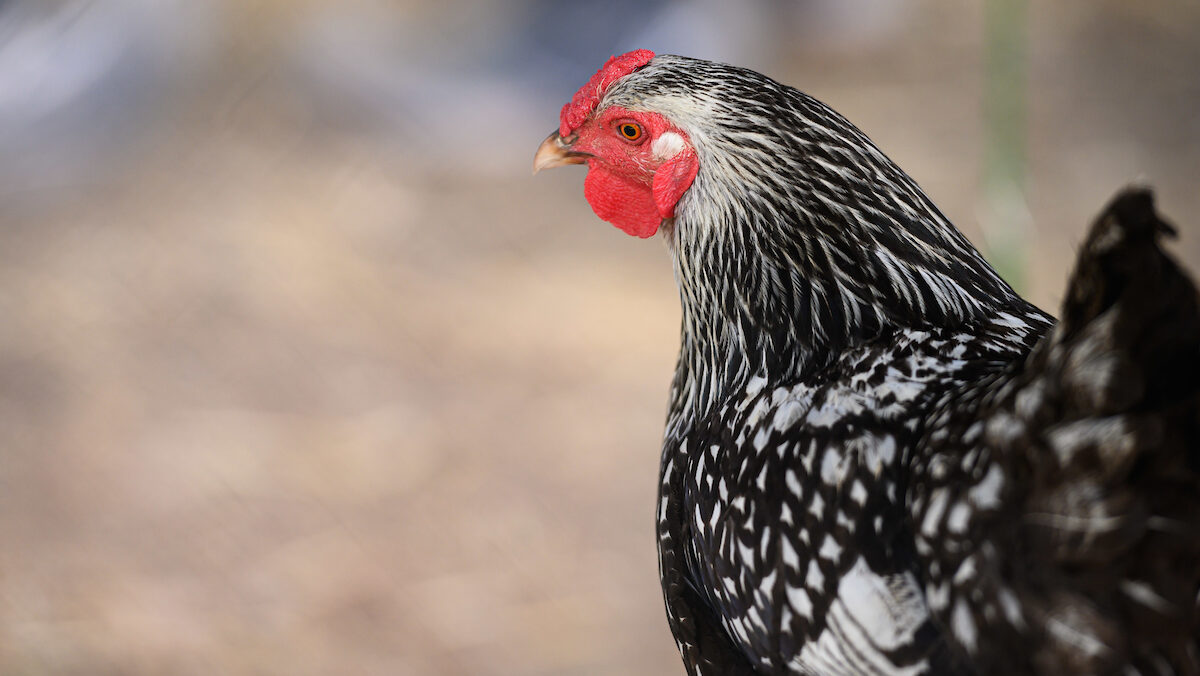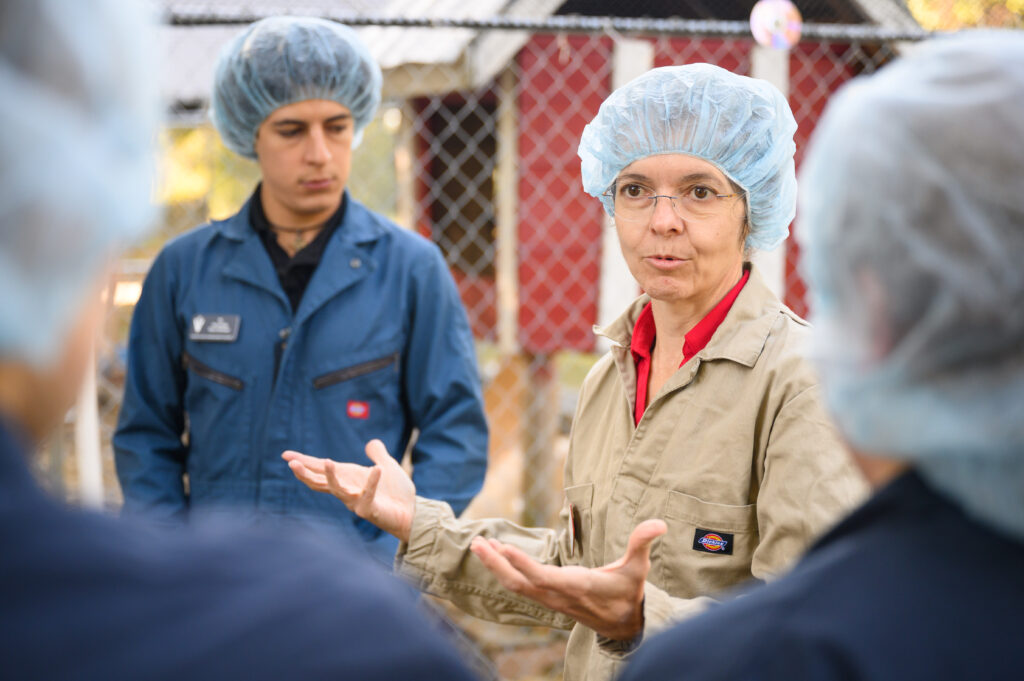What is avian influenza and what does it mean for you, farmers and backyard flocks?
Veterinarians and researchers at the NC State College of Veterinary Medicine are working to better understand highly pathogenic avian influenza and help the poultry industry manage its risks.

The poultry industry makes up the single-largest share of farm cash receipts in North Carolina, equating to a $34 billion economic impact annually.
But a small virus can quickly take a massive chunk out of that.
Nine commercial poultry farms were infected by a strand of highly pathogenic avian influenza two years ago, resulting in the loss of more than 480,000 birds. Now, after a year of only small cases in backyard flocks, the concern for larger loss has returned for North Carolina poultry farmers and chicken owners. Avian influenza has already impacted two commercial poultry farms in the state this year.
The virus, which is carried by ducks, geese and other waterfowl who are migrating and travel freely, can have a devastating effect when passed to chickens and turkeys, killing more than 90% of the poultry it infects. This poses challenges for not only farmers, but also our wallets and potentially our own health.
Veterinarians and researchers at the NC State College of Veterinary Medicine are working to better understand highly pathogenic avian influenza and help the poultry industry manage its risks. Among that group is Dr. Rocio Crespo, whose research includes investigating the pathogenesis and diagnosing diseases in poultry.
As the avian influenza begins to impact our state, Crespo discussed the virus and what it means for commercial farms, backyard flocks and the average person.
What is avian influenza, and what happens when a bird catches it?
Avian influenza is a virus, a viral disease. It’s a very tiny virus, so it moves very quickly and transfers through the air very easily. It’s the same [impact] as in humans. We get the flu. We get the vaccine. Some people get very sick. Some years, the flu is worse than in other years, and the same happens with avian influenza. Some avian influenzas do not kill birds, and there are some avian influenzas that do. The outbreak we are currently experiencing is killing lots of birds.
When we talk about avian influenza and why important it is, it is because of how it affects poultry. It may not affect other species. Ducks many times are what we call the “host,” so they carry the influenza and pass it around, but they may not die. But when we classify influenza as a high-pathogen influenza, it’s based on what the virus does to our domestic poultry, mainly chickens.
Why are chickens more susceptible to dying from avian influenza?
The virus is not adapted to the chicken. Once it starts to be in the chicken, it then starts to change to try to adapt itself to the chicken, and then it may become highly pathogenic.
This strain that we have had these last two years is generally pathogenic. It didn’t have to change. The one we had in 2014 was another one that didn’t have to change. It went straight into the birds, and it was killing the birds without any changes.
How quickly can an avian influenza spread through a flock?
It’s usually three to four days from catching the influenza to dying. It’s very quick. But in those three or four days, they are shedding. So, they may not be showing signs, but because they are drinking the same water as the other ones, they are passing the virus. And you hear about the “pecking order.” They will peck on a sick bird, and then they will pick up the virus.
In a commercial flock, where they are close together, it will spread like wildfire. In three or four days, most of them are affected. If you have a small flock, it may take a week or two to get affected. It is “when,” not “if” other birds will have it.
A farmer could lose thousands of chickens if the virus spreads throughout a flock. The USDA can compensate the farmer for the animals, but how damaging can this be for a commercial farmer and the average consumer?
You see the prices of the eggs going up. It’s not just the birds that you are losing there. The farmer will have to order new babies and then they have to grow up. When you have a flock that you have to wait for 20 weeks to get into production, you are losing production time.
What is the NC State College of Veterinary Medicine doing to tackle this problem?
We educate. Education is important. When I go out and talk about management with folks, we are talking about, “Are you going to have them running free in the yard, or are you going to keep them confined in a fenced area with a roof over them so the wild birds cannot have access to everything? Where are you going to put the feed and the water?” They say, “I don’t want to have them confined because there’s a blueberry bush that they love.” Then it’s, “OK. Don’t put water anywhere in here. Just keep the water inside the coop so they will have to come in here.” It’s about how you are going to manage to keep that discrimination of, “No, this is my space; my chicken space is not the wild bird space.”
One of the things we are doing right now is more in commercial, and I am working with [College of Veterinary Medicine Associate Professor] Gustavo Machado. We have received some money from the USDA for emergency diseases. One of the problems commercial poultry has are their biosecurity plans. They are handwritten. Those things are very hard to compare Farm One to Farm Two. Are they the same? Are there different gaps? We are trying to standardize those biosecurity plans. The plant can do whatever it wants to do for the plan, but then we analyze and say, “OK, this one is missing this part.” We found when we were doing the analysis that many of them allow animals like dogs and cats on the farm. We know that they transfer diseases. That’s a no-no for our biosecurity. Still, more than 20% of farms keep those animals on the farm.
If you have an outbreak, the federal government has to come, and they have to know where they have to change clothes and what is considered a clean area from a dirty area of the disease. These biosecurity plans don’t have a map that says, “This is clean. This is dirty.” They have a description. It’s very hard for someone who’s never been on the farm to know. We are helping the producers to create those maps. So, the standardization is the map. And then once we have that data, we will be able to start modeling. Are we going to use vaccination? Are we going to change the route of our delivery drugs? Are we going to move the birds from this area to this area? What are my risks?

There have been more and more reports of avian influenza spreading to mammals. Should we be concerned about humans catching this?
Not in the United States and not currently. But this virus is also related to the Hong Kong flu virus in 2008. So there is a potential of infecting humans.
In Hong Kong, China, the relationship between chickens and humans is closer. They won’t keep the dog in the house, but they will keep the chicken in the house. So, they are more closely related to the chicken. So the chances of infection are higher.
There is a girl in Ecuador who died of avian flu, of this flu here, but by the time she started to show clinical signs, all the birds in the backyard had died, so they were not able to say, “Is that from the bird that you had?” But she was actually sick. And in all these outbreaks, there are always the people who are most in contact with those sick birds. They may get sick.
Whether it’s a commercial farmer or the owner of a backyard flock, what can people who are around poultry do to protect themselves?
Like all other diseases: hygiene. Wash your hands. Don’t kiss the chicken. Just wash your hands after you hold the animals, or you clean up. Make sure that the clothes that you wear are not the ones that you are going to be in the house with or cook with or something.
We can control our pets. So just make sure that they don’t interact. Some people live in farm communities, and they have a pond in the backyard and the wild ducks come over and many times they intermingle their domestic ducks. Avoid that type of intermingling. Keep the feed away from the wild animals. Keep water away from wild animals.
If you have sick birds or suspect anything, call the veterinarian.


